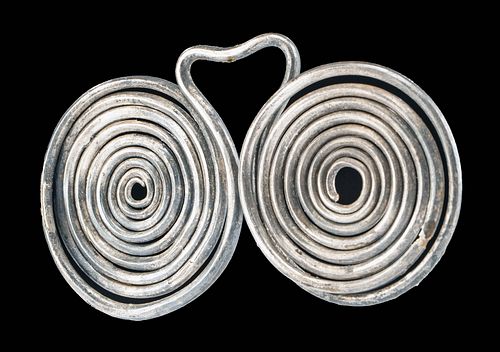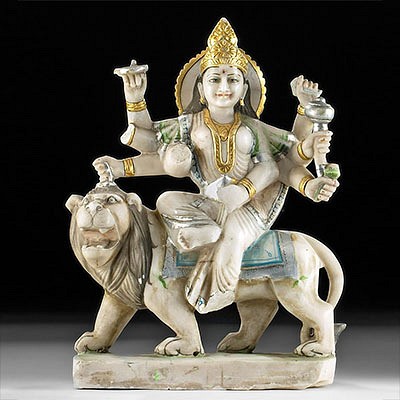Greek Thracian Silver Spectacle Fibula - 39.3 g
Lot 10
About Seller
Artemis Fine Arts
686 S Taylor Ave, Ste 106
Louisville, CO 80027
United States
Selling antiquities, ancient and ethnographic art online since 1993, Artemis Gallery specializes in Classical Antiquities (Egyptian, Greek, Roman, Near Eastern), Asian, Pre-Columbian, African / Tribal / Oceanographic art. Our extensive inventory includes pottery, stone, metal, wood, glass and textil...Read more
Categories
Estimate:
$900 - $1,350
Absentee vs Live bid
Two ways to bid:
- Leave a max absentee bid and the platform will bid on your behalf up to your maximum bid during the live auction.
- Bid live during the auction and your bids will be submitted real-time to the auctioneer.
Bid Increments
| Price | Bid Increment |
|---|---|
| $0 | $25 |
| $300 | $50 |
| $1,000 | $100 |
| $2,000 | $250 |
| $5,000 | $500 |
| $10,000 | $1,000 |
| $20,000 | $2,500 |
| $50,000 | $5,000 |
| $100,000 | $10,000 |
| $200,000 | $20,000 |
About Auction
By Artemis Fine Arts
Jul 16, 2020
Set Reminder
2020-07-16 10:00:00
2020-07-16 10:00:00
America/New_York
Bidsquare
Bidsquare : Ancient / Ethnographic Art Through The Ages
https://www.bidsquare.com/auctions/artemis-gallery/ancient-ethnographic-art-through-the-ages-5334
Ancient art from Egypt, Greece, Italy and the Near East, as well as Asian, Fossils, Pre-Columbian, Native American, African / Tribal / Oceanic, Spanish Colonial, Russian Icons, Fine art, much more! Artemis Fine Arts info@artemisfinearts.com
Ancient art from Egypt, Greece, Italy and the Near East, as well as Asian, Fossils, Pre-Columbian, Native American, African / Tribal / Oceanic, Spanish Colonial, Russian Icons, Fine art, much more! Artemis Fine Arts info@artemisfinearts.com
- Lot Description
Northern Greece, Thrace, Late Bronze Age, ca. 700 BCE. A wonderful high-grade silver spectacle (97.5% silver), or double spiral, fibula (brooch) created from a single length of gold wire, which has been tightly coiled in about eight revolutions at each end creating two large spirals. The spirals, connected by a raised loop, sit opposite one another in an attractive symmetrical composition. Weight: 39.3 grams Size: 3.2" W x 1.75" H (8.1 cm x 4.4 cm). Precious metal quality: 97.5% silver.
According to O. Hammer, "Neolithic and Bronze Age Europeans were crazy about spirals. The spiral is so pervasive in rock art, jewelry and architecture that it characterizes and unites cultures from Scandinavia to Egypt through several thousand years. It is a super-symbol, turning up everywhere, in ever-changing configurations and combinations. Scholars debate endlessly about its meaning—perhaps it represented the sun, perhaps it had a botanical origin, perhaps it signified ocean waves, or it was a symbol of eternity, or illustrated shamanistic experiences, or was just for decoration. Quite likely, several of these played a role, perhaps changing in relative importance over time. In any case, the massive use of spirals, often in ritualistic settings, indicates that they often carried some deep, mystical meaning, now forever lost by the passage of millennia and the victories of newer religions." (Hammer O. (2016) Pagan Coils. In: The Perfect Shape. Copernicus, Cham)
Provenance: ex-Phoenicia Holyland Antiquities; ex Taisei Gallery Collection Auction, New York City, New York, USA November 1992, Lot #144
All items legal to buy/sell under U.S. Statute covering cultural patrimony Code 2600, CHAPTER 14, and are guaranteed to be as described or your money back.
A Certificate of Authenticity will accompany all winning bids.
We ship worldwide and handle all shipping in-house for your convenience.
#155082Intact! Very slight bending to form near center. Presents a very rich patina that has develop over approximately 2700 years.Condition
- Shipping Info
-
All shipping is handled in-house for your convenience. Your invoice from Artemis Gallery will include shipping calculation instructions. If in doubt, please inquire BEFORE bidding for estimated shipping costs for individual items.
-
- Buyer's Premium



 EUR
EUR CAD
CAD AUD
AUD GBP
GBP MXN
MXN HKD
HKD CNY
CNY MYR
MYR SEK
SEK SGD
SGD CHF
CHF THB
THB














